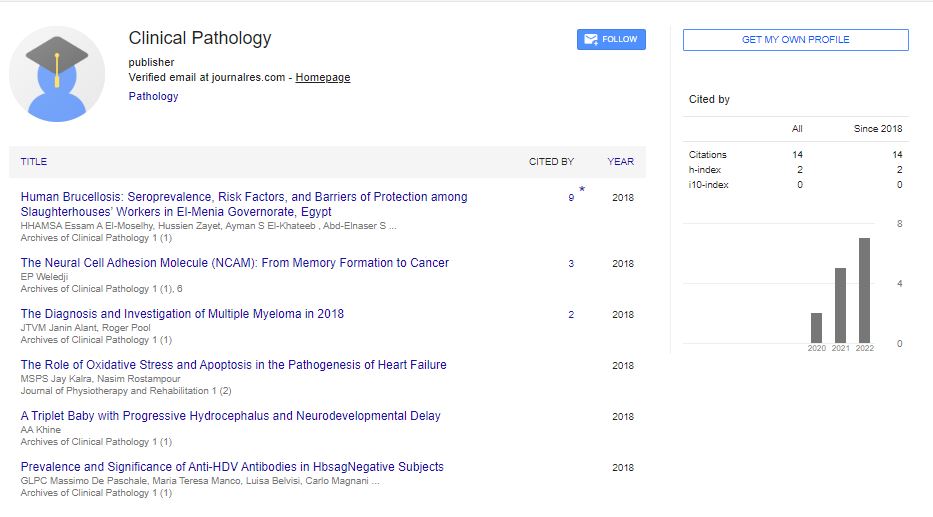Perspective, Arch Clin Pathol Vol: 6 Issue: 3
Understanding the Complexities of Hematopathology
Caceres Carmine*
1Department of Medicine, University of Verona, Verona, Italy
*Corresponding Author: Caceres Carmine,
Department of Medicine, University of
Verona, Verona, Italy
E-mail: carmine08@childrens.harvard.edu
Received date: 30 August, 2023, Manuscript No. ACPY-23-117812;
Editor assigned date: 01 September, 2023, PreQC No. ACPY-23-117812 (PQ);
Reviewed date: 15 September, 2023, QC No. ACPY-23-117812;
Revised date: 22 September, 2023, Manuscript No. ACPY-23-117812 (R);
Published date: 02 October, 2023, DOI:2324-8955/acpy.05.03.100094
Citation: Carmine C (2023) Understanding the Complexities of Hematopathology. Arch Clin Pathol 6:3.
Abstract
Hematopathology is a subspecialty of pathology that focuses on the study of blood disorders and diseases that affect the blood and bone marrow. This critical field plays a vital role in diagnosing and understanding conditions such as leukemia, lymphoma, anemia, and various other hematological disorders. To appreciate hematopathology, one must first understand the normal processes of hematopoiesis-the formation of blood cells. Hematopoiesis occurs primarily within the bone marrow, where stem cells differentiate into red blood cells (erythrocytes), white blood cells (leukocytes), and platelets (thrombocytes). These blood components play crucial roles in oxygen transport, immune function, and clotting.
Description
Hematopathology is a subspecialty of pathology that focuses on the study of blood disorders and diseases that affect the blood and bone marrow. This critical field plays a vital role in diagnosing and understanding conditions such as leukemia, lymphoma, anemia, and various other hematological disorders. In this article, we will explore hematopathology and delve into the intricacies of these blood-related diseases and their underlying pathology.
To appreciate hematopathology, one must first understand the normal processes of hematopoiesis-the formation of blood cells. Hematopoiesis occurs primarily within the bone marrow, where stem cells differentiate into red blood cells (erythrocytes), white blood cells (leukocytes), and platelets (thrombocytes). These blood components play crucial roles in oxygen transport, immune function, and clotting.
Common blood disorders
Leukemia: Leukemia is a cancer of the blood-forming tissues, including the bone marrow. The pathology of leukemia involves the uncontrolled proliferation of white blood cells, often resulting in an overproduction of immature cells. Leukemia can be classified into acute or chronic forms, and further subtypes based on the type of white blood cells affected.
Lymphoma: Lymphoma is a cancer that affects the lymphatic system, which includes lymph nodes, spleen, and bone marrow. The pathology of lymphoma involves the malignant transformation of lymphocytes, leading to the formation of tumors. There are two primary types of lymphoma: Hodgkin's lymphoma and non-Hodgkin's lymphoma, each with various subtypes.
Anemia: Anemia is a condition characterized by a reduction in the number of red blood cells or a decrease in the amount of haemoglobin in the blood. The pathology may involve factors such as impaired production, increased destruction, or blood loss. Anemia can result from various underlying causes, including nutritional deficiencies, chronic diseases, or genetic conditions.
Myeloproliferative disorders: Myeloproliferative disorders involve the excessive production of blood cells in the bone marrow. Conditions like polycythaemia vera, essential thrombocythemia, and myelofibrosis are among the diseases in this category. The pathology often includes genetic mutations that drive abnormal cell growth and differentiation.
Diagnosis and pathological evaluation
Diagnosing blood disorders and understanding their pathology typically involves a combination of laboratory tests, imaging, and pathological analysis. Key diagnostic tools include:
Blood smear: A blood smear is a microscopic examination of a stained blood sample, which allows pathologists to assess the shape and size of blood cells, identifying abnormalities or irregularities.
Bone marrow biopsy: A bone marrow biopsy involves the collection of a sample from the bone marrow. Pathologists analyze these samples to determine cell composition, identify the presence of cancer cells, or evaluate other conditions affecting the marrow.
Flow cytometry: Flow cytometry is a technique used to analyze the physical and chemical characteristics of cells. It is particularly valuable in distinguishing different types of leukemia and lymphoma.
Molecular and genetic testing: Advances in genetics have enabled the identification of specific genetic mutations and chromosomal abnormalities that play a role in many hematological disorders.
Treatment and research
The treatment of hematological disorders varies based on the specific diagnosis and its pathology. Common treatment options include chemotherapy, radiation therapy, stem cell transplantation, and targeted therapies, among others.
Research in hematopathology is ongoing, with a focus on better understanding the genetic and molecular mechanisms driving blood disorders. Advances in personalized medicine are helping to tailor treatment approaches to individual patients based on their specific pathology and genetic makeup.
Conclusion
Hematopathology is a critical field that bridges the gap between understanding the pathology of blood disorders and providing patients with effective diagnosis and treatment. This subspecialty continues to evolve, contributing to the improvement of patient care and outcomes for individuals with leukemia, lymphoma, anemia, and other hematological conditions. As research and technology progress, the future of hematopathology holds promising opportunities for earlier and more precise diagnoses, ultimately improving the lives of those affected by these diseases.
 Spanish
Spanish  Chinese
Chinese  Russian
Russian  German
German  French
French  Japanese
Japanese  Portuguese
Portuguese  Hindi
Hindi 